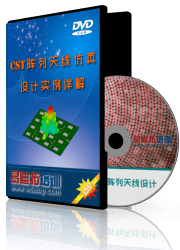- 易迪拓培训,专注于微波、射频、天线设计工程师的培养
CST MWS仿真天线能量得不到扩散怎么解决
模型如下:

功分器分配的功率从左到右为切比雪夫分布,关于中心对称的。
仿真不能完全结束就停止掉了,能量曲线如图:

并且出现警告:Maximum simulation time reached, solver stopped.
Please note that the steady state energy criterion has not been satisfied. More...
1 warning occurred.
点击More,出现:
Maximum number of pulse widths simulated, solver stopped. / Maximum simulation time reached, solver stopped. Please note that the steady state energy criterion has not been satisfied.
The transient solver operates with a time pulse as excitation, and the simulation stops when one of the following conditions are met:
•
Either the remaining energy in the calculation domain as well as the port signals have decreased to the steady state value specified on the time domain solver parameter page in the Accuracy field.
•
The simulation time reaches the maximum solver duration, either defined as Time, Number of pulses or Propagation distance on the Steady state tab on the Special Time Domain Solver Parameter page.
The warning appears when the latter condition was satisfied first before the accuracy level has been reached. This means the energy level remaining in the structure is still bigger than the specified steady state value. Usually this is the case for resonating (energy stays inside the structure for a long time) or large structures (it takes a long time for a pulse to penetrate through the structure). The extra energy would appear as a truncation error, which causes some ripples in the S-parameter curves.
Recommended solutions are the following:
•For non-resonating structures, the maximum solver duration setting can be adjusted, with the appropriate choice of defining number of pulses or a time or propagation distance setting.
•For resonating structures a much better approach would be to activate the Autoregressive Filter (see advanced Topics manual) on the AR Filter tab on the Special Time Domain Solver Parameter page, which allows to shorten the simulation time and in addition to avoid the truncation error.
根据解决办法,是需要激活AR-Filter功能,但是激活完就会发现能量只衰减了一点点就停掉了,虽然没有警告,但是觉得结果很不不可靠!
之前我在仿真功分器的时候也出现这种情况,多亏了hawk8969 大神帮我解决了,主要是背景材料中的距离设置的太小了,估计有点空间谐振了,所以出现这种情况,但是这次完全是根据软件自己设定的空气盒子的大小确定的,默认的,所以没改动,我试了一下将upper Z改成20,结果更差,只衰减到-25.8dB,所以我猜想不是这个原因

S11也很差,全是毛刺,不知道为什么

但是方向图感觉还可以

但是有警告的结果不敢相信,有没有人遇到过这种情况,帮忙解决一下啊,谢谢!!
网友回复:
最近在研究切比雪夫分布的天线阵列,仿了一个1*8的天线矩形微带天线阵列,但是能量曲线一直到不了-30dB
模型如下:
[attachment=60687]
功分器分配的功率从左到右为切比雪夫分布,关于中心对称的。
仿真不能完全结束就停止掉了,能量曲线如图:
[attachment=60689]
并且出现警告:Maximum simulation time reached, solver stopped.
Please note that the steady state energy criterion has not been satisfied. More...
1 warning occurred.
点击More,出现:
Maximum number of pulse widths simulated, solver stopped. / Maximum simulation time reached, solver stopped. Please note that the steady state energy criterion has not been satisfied.
The transient solver operates with a time pulse as excitation, and the simulation stops when one of the following conditions are met:
•
Either the remaining energy in the calculation domain as well as the port signals have decreased to the steady state value specified on the time domain solver parameter page in the Accuracy field.
•
The simulation time reaches the maximum solver duration, either defined as Time, Number of pulses or Propagation distance on the Steady state tab on the Special Time Domain Solver Parameter page.
The warning appears when the latter condition was satisfied first before the accuracy level has been reached. This means the energy level remaining in the structure is still bigger than the specified steady state value. Usually this is the case for resonating (energy stays inside the structure for a long time) or large structures (it takes a long time for a pulse to penetrate through the structure). The extra energy would appear as a truncation error, which causes some ripples in the S-parameter curves.
Recommended solutions are the following:
•For non-resonating structures, the maximum solver duration setting can be adjusted, with the appropriate choice of defining number of pulses or a time or propagation distance setting.
•For resonating structures a much better approach would be to activate the Autoregressive Filter (see advanced Topics manual) on the AR Filter tab on the Special Time Domain Solver Parameter page, which allows to shorten the simulation time and in addition to avoid the truncation error.
根据解决办法,是需要激活AR-Filter功能,但是激活完就会发现能量只衰减了一点点就停掉了,虽然没有警告,但是觉得结果很不不可靠!
之前我在仿真功分器的时候也出现这种情况,多亏了hawk8969 大神帮我解决了,主要是背景材料中的距离设置的太小了,估计有点空间谐振了,所以出现这种情况,但是这次完全是根据软件自己设定的空气盒子的大小确定的,默认的,所以没改动,我试了一下将upper Z改成20,结果更差,只衰减到-25.8dB,所以我猜想不是这个原因
[attachment=60688]
S11也很差,全是毛刺,不知道为什么
[attachment=60690]
但是方向图感觉还可以
[attachment=60691]
但是有警告的结果不敢相信,有没有人遇到过这种情况,帮忙解决一下啊,谢谢!!
网友回复:
模型在1楼,之前忘记上传了,不好意思
网友回复:
我设置的的频率是2.45GHz
网友回复:
不使用对称面试试
网友回复:
还是不行哎,怎么回事呢
网友回复:
“仿真不能完全结束就停止掉了”,没有这种说法!仿真停止就是结束了,仿真没停止就没有结束。仿真软件里停止(或结束)是通过条件判断的,理论上高斯激励之后器件内的能量全部耗散完是结束的条件,但是这是不可能的,因此仿真软件里引入了“数值噪声”的概念。数值噪声定义为和激励能量的一个比值,这个数值就是time domain solver里accuracy这个参数。默认-30 dB意味着数值噪声为激励能量的千分之一,设置为-50 dB就是十万分之一。对于有些模型,能量耗散得极其缓慢,因此时域仿真同时规定了最大仿真时间,默认是20个激励信号的长度。如果在20个信号长度之内,数值噪声达到accuracy的数值,仿真停止(结束);否则,到20个信号长度时仿真仍然停止(结束)。因此没有“仿真不能完全结束就停止掉了”这种说法!(请仔细阅读帮助文件的内容)
AR-Filter是一种解决方案,但是请注意是有适用条件的!帮助文件使用的是“would”,不是“is”!使用AR-Filter的目的就是为了让field energy只衰减一点点就结束仿真,缩短仿真时间。否则使用AR-Filter又继续跑完field engergy的意义是什么?至于结果可不可靠,和仿真运行了多久没有逻辑关系。
S11“应该”是什么样,楼主应该自己心里有数。否则仿真就变成了摸奖,全凭撞大运。运行出来一个结果连是不是“合理”的都说不准。
“有警告的结果不敢相信”,如果这是真理,那么这个世界上没有几个EMC的模型可以做仿真了。
楼主的模型:

精力有限就不详细分析了,但是网格的处理很费解,尤其是substrate的local mesh properties,不理解为什么要设置为厚度的三分之一。介质厚度是0.25毫米,三分之一就是0.083毫米,这就是模型的minimum mesh step,非常小,导致仿真的时间会拖得非常久,根本没必要!这个数值设置为0.2毫米就已经能计算出正确的line impedance了。

把仿真频率设置为0-5 GHz,global mesh properties设置为10、10、10,取消metal edge refinement factor。Time domain solver激活adaptive mesh refinement,得到的S11:

网格优化对S11的影响:

Field Engergy:

Field energy耗散得慢这是这个模型自身的特性,但不见得AR-Filter就是这个模型的解决方案。
Port Signal:

Port signal可以看到端口反射能量很不规律,个人不认为这样的模型适用AR-Filter。在time domain solver里激活online AR-Filter并不会缩短仿真时间,也验证了我的观点。如果要得到很低的field energy,只能增大maximum simulation time。在0-5 GHz的前提下,激励时长是0.7纳秒,那么20个脉冲长度就是14纳秒左右。要得到比如-50 dB的field energy,大概需要60-80个脉冲长度。在Pass 6 940680个网格的条件下,我的8核工作站仿真时间是19分钟,因此60-80个脉冲长度大概需要一到一个半小时。
需要特别强调的是,仿真结果是否准确只取决于网格划分的是否合理,和field energy是否耗散到很低无关!Trunction error只是让S参数曲线存在“波纹”,对于数值准确性本身没有影响!
帮助文件需要仔细阅读:《Mesh Generation Overview》、《AR-Filter Overview》、《Time Domain Solver Performance Improvement》、《Signals in Time Domain Simulation》。
老帖也值得参考:本专区的“CST MWS计算腔体屏蔽效能的问题”。
网友回复:
我想这个能量不消散是不是因为带宽太窄了,能量一直在功分器里面震荡?
网友回复:
首先感谢你每次都能不遗余力的帮我解决问题,非常感谢!!!
虽然我是新手,但是你说的有些东西我还是有些不同意,我之前看到论坛里面的视频上说,就是CST官方的视频,对于微带结构,网格设置要求是≤35,≤35,≥50,而你的设置是10,10,10,个人感觉有些不妥,另外,我设置substrate的网格剖分是substrate厚度的三分之一也是根据帮助文档里面的要求来的,具体我记不清在哪边看的了
网友回复:
首先来说网格,35,35,50的设置只是推荐值,并不是必须的
如果网格质量很好,10,10,10也没问题,尤其是还有子网格的存在
substrate设置三分之一还是二分之一我想区别应该不大,记得好像是至少有一条网格线即可
申明:网友回复良莠不齐,仅供参考。如需专业解答,请学习易迪拓培训专家讲授的CST视频培训教程。
上一篇:CST MWS frequency domain solver 如何设置对称面?
下一篇:CST CS中监测电场值











